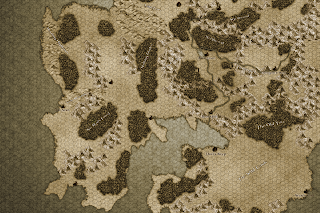Fantasy Map Review VII: Erce

For links to all instalments in this series, go here . Final instalment in my review series of classical maps is my own - The Mythlands of Erce! The main large map is more or less finished by now. Click here to download the full size 6000x4000 map It would seem a bit puerile to review what I like and don't like about my own map, so I am just going to talk a bit about what I am trying to do with it, the process and how I feel about the result. One of the touches I am pretty happy with (and which really helped me figure out the proper scale of symbols as well) is that this is actually a hex map. Each mountain is a hex, woodlands border to hexes, albeit lazily, so do hills, etc. So this can actually be used a table, players can be told what hex they are in and see what can of primary terrain it has, calculate overland travel, etc (I didn't go for hexes for the seas because imo, sea travel is almost always a pointcrawl anyway). I feel like I have to show a slightly ...






